air conditioning FORD FIESTA 2007 Workshop Manual
[x] Cancel search | Manufacturer: FORD, Model Year: 2007, Model line: FIESTA, Model: FORD FIESTA 2007Pages: 1226, PDF Size: 61.26 MB
Page 4 of 1226
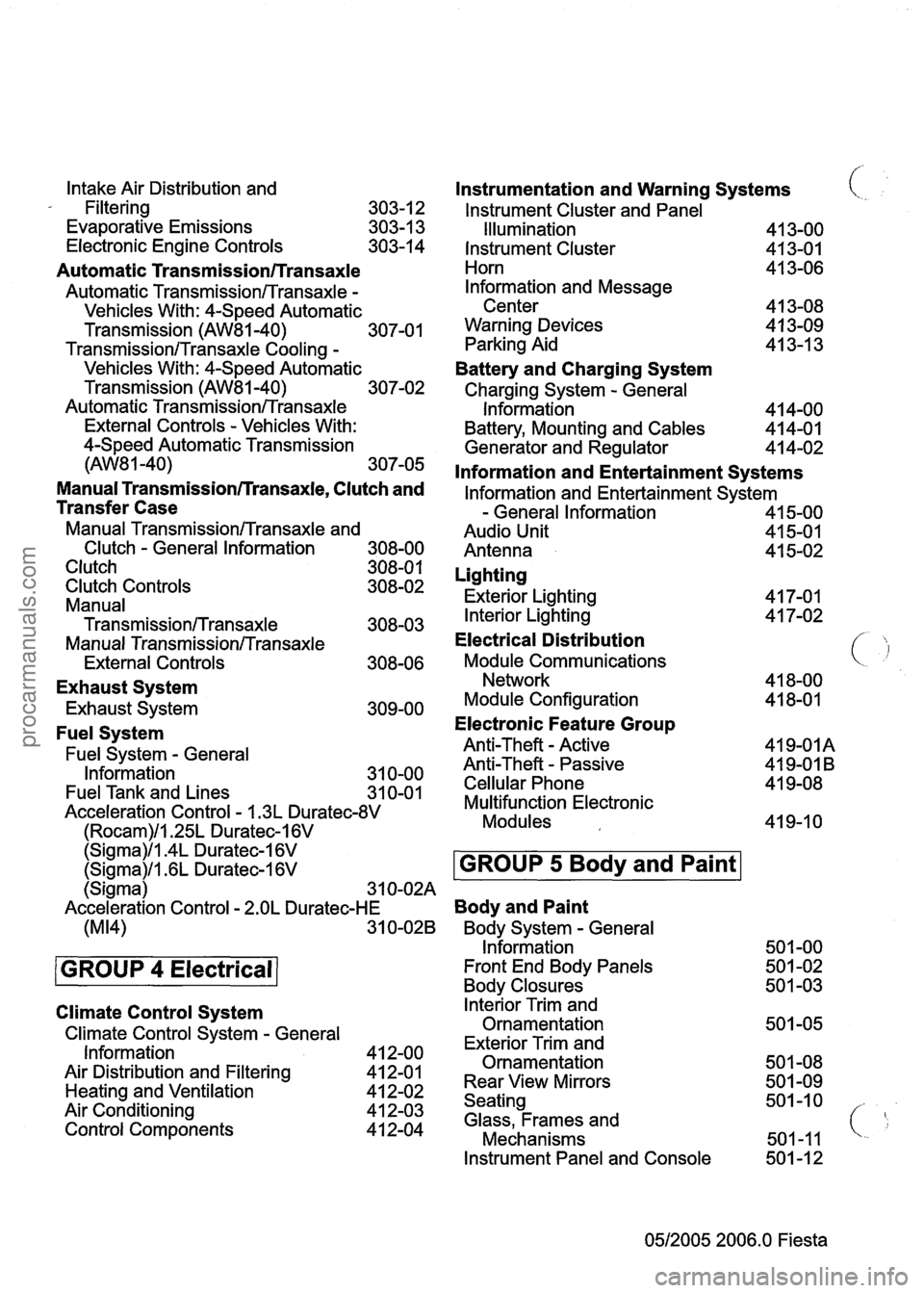
Intake Air Distribution and
- Filtering
303-1 2
Evaporative Emissions 303-1 3
Electronic Engine Controls 303-14
Automatic Transmission/Transaxle
Automatic TransmissionlTransaxle -
Vehicles With: 4-Speed Automatic
Transmission
(AW81-40) 307-01
TransmissionlTransaxle Cooling -
Vehicles With: 4-Speed Automatic
Transmission
(AW81-40) 307-02
Automatic
TransmissionlTransaxle
External Controls - Vehicles With:
4-Speed Automatic Transmission
(AW8 1 -40) 307-05
Manual Transmissionrrransaxle, Clutch and
Transfer Case
Manual TransmissionlTransaxle and
Clutch
- General Information 308-00
Clutch 308-0 1
Clutch Controls 308-02
Manual
Transmission/Transaxle 308-03
Manual TransmissionlTransaxle
External Controls 308-06
Exhaust System
Exhaust System 309-00
Fuel System
Fuel System - General
Information 31 0-00
Fuel Tank and Lines
31 0-01
Acceleration Control - I .3L Duratec-8V
(Rocam)ll.25L Duratec-I 6V
Instrumentation and Warning Systems
lnstrument Cluster and Panel
(
Illumination 41 3-00
Instrument Cluster
413-01
Horn 41 3-06
lnformation and Message
Center 41 3-08
Warning Devices
4 1 3-09
Parking Aid 41 3-1 3
Battery and Charging System
Charging System - General
Information 4 14-00
Battery, Mounting and Cables 414-01
Generator and Regulator 41 4-02
lnformation and Entertainment Systems
lnformation and Entertainment System
- General Information 41 5-00
Audio Unit 41 5-01
Antenna 41 5-02
Lighting
Exterior Lighting 41 7-01
Interior Lighting 4 1 7-02
Electrical Distribution
Module Communications ( 'j
Network 41 8-00
Module Configuration 41 8-01
Electronic Feature Group
Anti-Theft - Active 419-01A
Anti-Theft
- Passive 41 9-01 B
Cellular Phone 41 9-08
Multifunction Electronic
Modules 41 9-1 0
Climate Control System
Climate Control System - General
Information
Air Distribution and Filtering
Heating and Ventilation
Air Conditioning
Control Components
(Sigma)ll.4L Duratec-I 6V
lnterior Trim and
Ornamentation
Exterior Trim and
Ornamentation
Rear View Mirrors
Seating
Glass, Frames and
Mechanisms
(Sigma)/l .6L Duratec-1 6V
Instrument Panel and Console 501 -1 2
0512005 2006.0 Fiesta
GROUP 5 Body and Paint
(Sigma) 3 1 0-02A
Acceleration Control
- 2.OL Duratec-HE Body and Paint
(M14) 31 0-028 Body System - General
Information 501 -00
GROUP 4 Electrical Front End Body Panels 50 1 -02
Body Closures 50 1 -03
procarmanuals.com
Page 13 of 1226
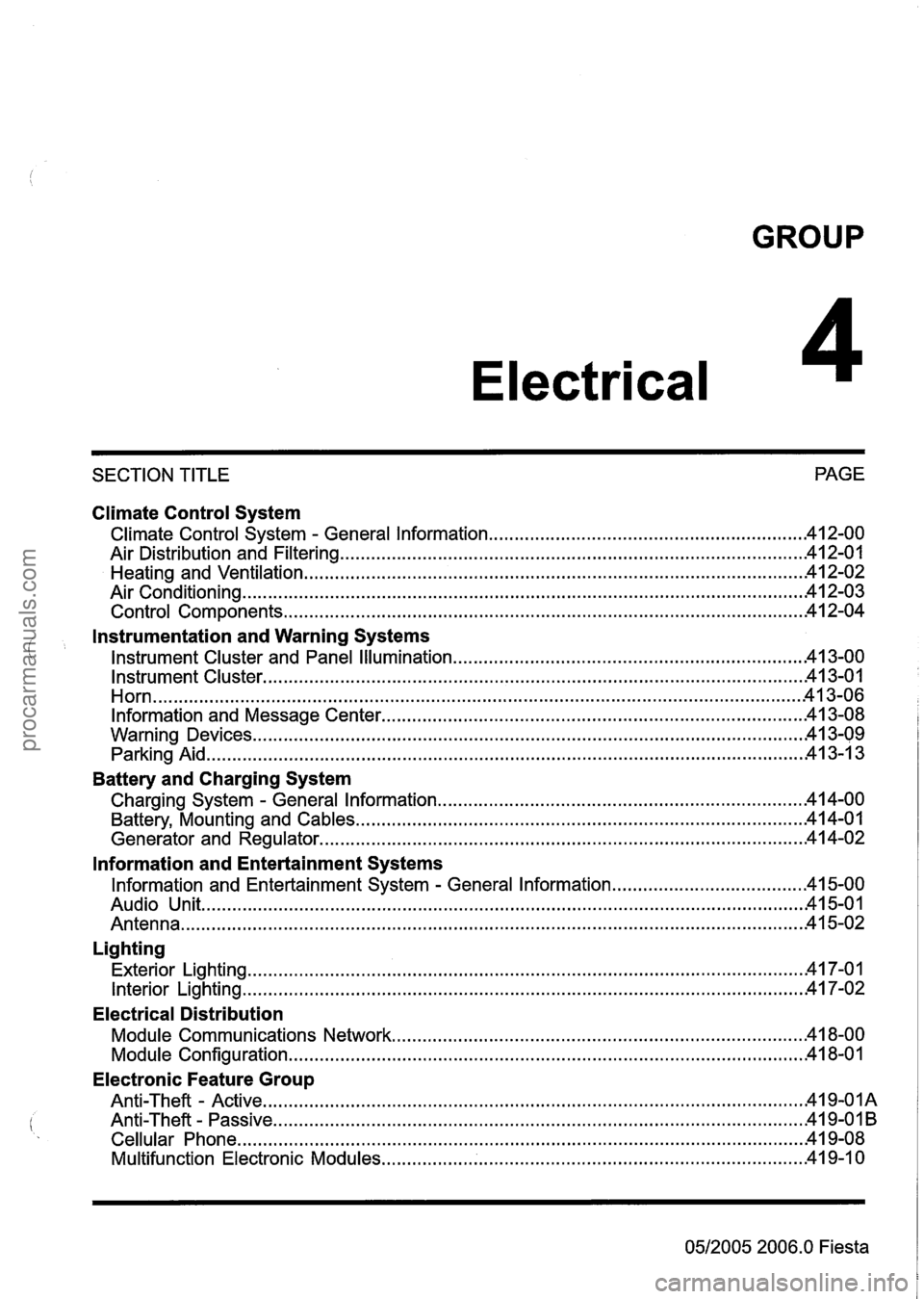
GROUP
Electrical
SECTION TITLE PAGE
Climate Control System
.......................................................... Climate Control System . General Information 42-00
........................................................................\
................... Air Distribution and Filtering 412-01
........................................................................\
......................... Heating and Ventilation .41 2-02
........................................................................\
..................................... Air Conditioning .41 2.03
........................................................................\
............................. Control Components .41 2.04
i
Instrumentation and Warning Systems
.................................................................... Instrument Cluster and Panel Illumination -41 3-00
........................................................................\
................................. Instrument Cluster .41 3-01
........................................................................\
...................................................... Horn -41 3-06
Information and Message Center ........................................................................\
........... 41 3-08
........................................................................\
................................... Warning Devices -41 3-09
........................................................................\
............................................. Parking Aid 413-1 3
Battery and Charging System
Charging System . General Information ..................................................................... 14-00
........................................................................\
............... Battery, Mounting and Cables -41 4-01
........................................................................\
...................... Generator and Regulator .41 4-02
lnformation and Entertainment Systems
Information and Entertainment System . General Information ..................................... .41 5-00
Audio Unit ........................................................................\
.............................................. 15-01
........................................................................\
................................................. Antenna .41 5-02
Lighting
........................................................................\
.................................... Exterior Lighting .41 7.01
........................................................................\
..................................... Interior Lighting -41 7-02
Electrical Distribution
........................................................................\
......... Module Communications Network 18-00
........................................................................\
............................. Module Configuration 41 8-01
Electronic Feature Group
Anti-Theft - Active ........................................................................\
.................................. 419-OIA
........................................................................\
............................... Anti-Theft . Passive .4 I 9-0 I B
........................................................................\
.............................. Cellular Phone .........4 19-08
........................................................................\
........... Multifunction Electronic Modules 41 9-1 0
0512005 2006.0
Fiesta
procarmanuals.com
Page 17 of 1226
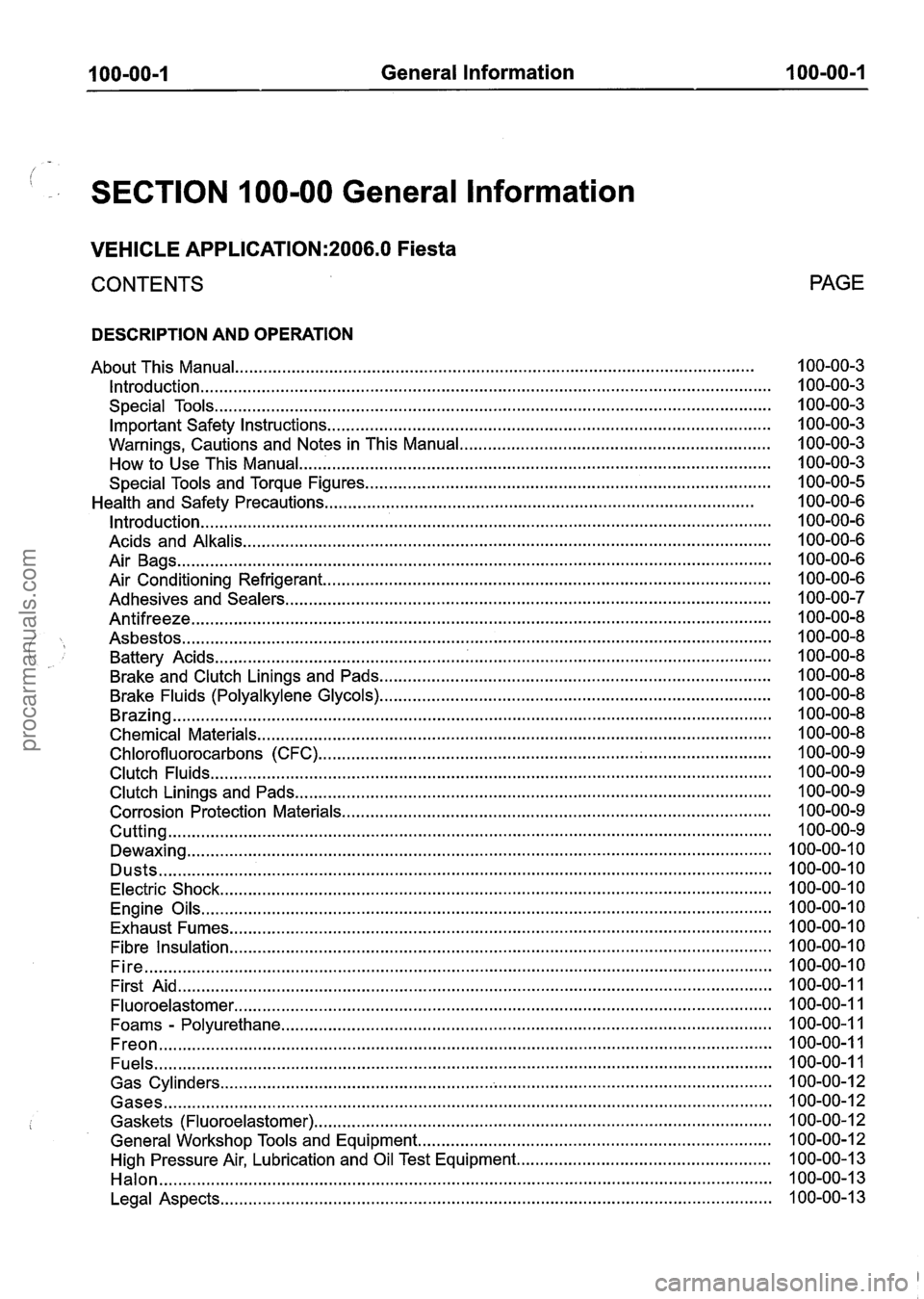
100-00-1 General Information 100-00-1
. SECTION 100-00 General lnformation
VEHICLE APPLICATION:2006.0 Fiesta
CONTENTS
DESCRIPTION AND OPERATION
About This Manual
........................................................................\
......................................
........................................................................\
................................................. Introduction
Special Tools
........................................................................\
..............................................
Important Safety Instructions ........................................................................\
......................
Warnings. Cautions and Notes in This Manual ..................................................................
How to Use This Manual ........................................................................\
............................
Special Tools and Torque Figures ........................................................................\
..............
Health and Safety Precautions ........................................................................\
...................
........................................................................\
................................................. Introduction
........................................................................\
........................................ Acids and Alkalis
Air Bags
........................................................................\
......................................................
Air Conditioning Refrigerant ........................................................................\
.......................
........................................................................\
............................... Adhesives and Sealers
........................................................................\
................................................... Antifreeze
........................................................................\
..................................................... Asbestos
Battery Acids
........................................................................\
..............................................
Brake and Clutch Linings and Pads ........................................................................\
...........
Brake Fluids (Polyalkylene Glycols) ........................................................................\
...........
........................................................................\
....................................................... Brazing
Chemical Materials
........................................................................\
.....................................
................................................................... Chlorofluorocarbons (CFC) ... ..........................
Clutch Fluids ........................................................................\
...............................................
Clutch Linings and Pads ........................................................................\
.............................
Corrosion Protection Materials ........................................................................\
...................
........................................................................\
........................................................ Cutting
........................................................................\
.................................................... Dewaxing
........................................................................\
.......................................................... Dusts
Electric Shock
........................................................................\
.............................................
Engine Oils ........................................................................\
.................................................
Exhaust Fumes ........................................................................\
...........................................
........................................................................\
........................................... Fibre Insulation
Fire
........................................................................\
.............................................................
First Aid ........................................................................\
......................................................
........................................................................\
.......................................... Fluoroelastomer
Foams
. Polyurethane ........................................................................\
................................
........................................................................\
.......................................................... Freon
........................................................................\
........................................................... Fuels
........................................................................\
.............................................. Gas Cylinders
........................................................................\
......................................................... Gases
Gaskets (Fluoroelastomer)
........................................................................\
.........................
General Workshop Tools and Equipment ........................................................................\
...
High Pressure Air. Lubrication and Oil Test Equipment ......................................................
........................................................................\
.......................................................... Halon
........................................................................\
............................................. Legal Aspects
PAGE
procarmanuals.com
Page 22 of 1226
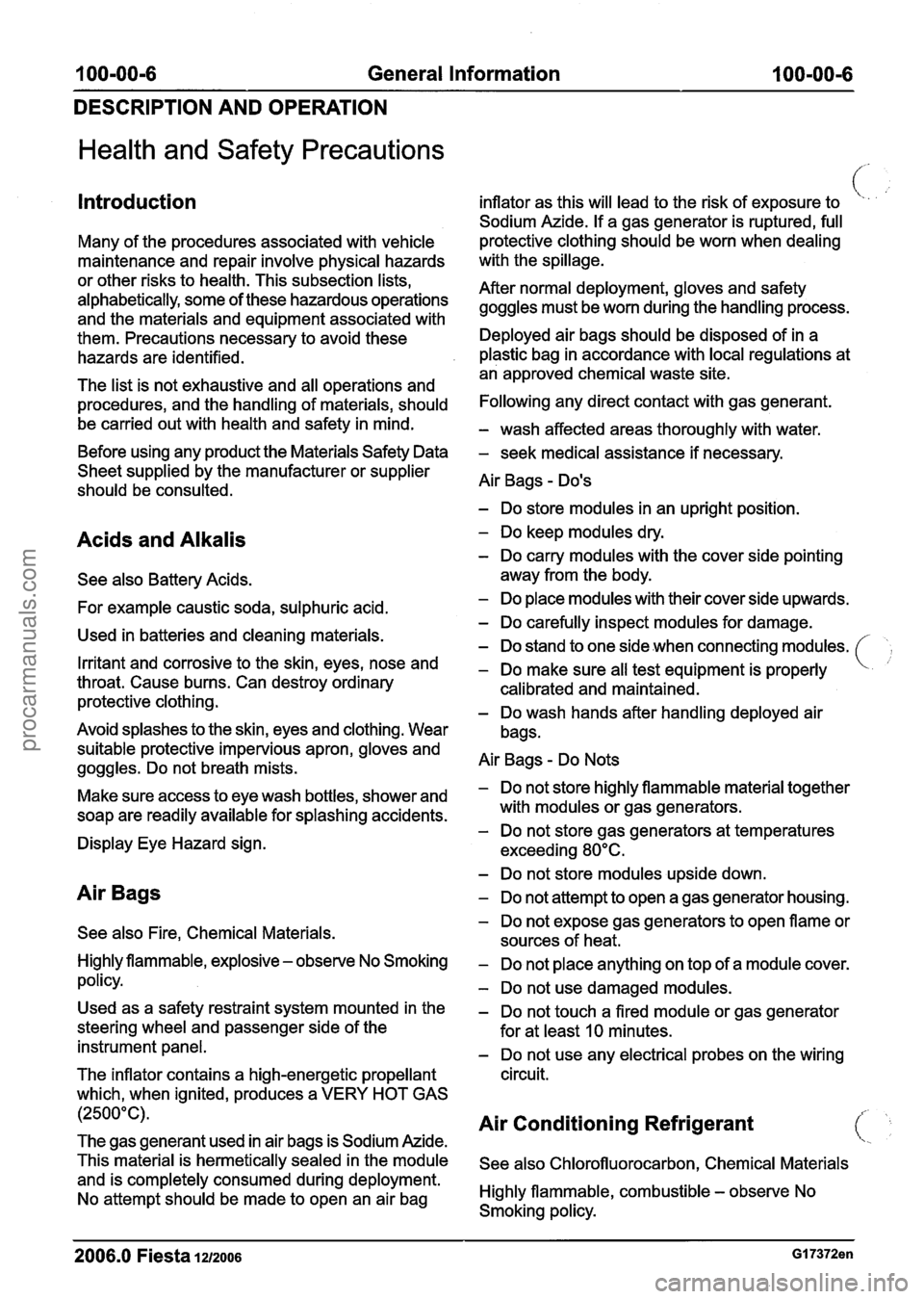
100-00-6 General Information 100-00-6
DESCRIPTION AND OPERATION
Health and Safety Precautions
Introduction
Many of the procedures associated with vehicle
maintenance and repair involve physical hazards
or other risks to health. This subsection lists,
alphabetically, some of these hazardous operations
and the materials and equipment associated with
them. Precautions necessary to avoid these
hazards are identified.
The list is not exhaustive and all operations and
procedures, and the handling of materials, should
be carried out with health and safety in mind.
Before using any product the Materials Safety Data
Sheet supplied by the manufacturer or supplier
should be consulted.
Acids and Alkalis
See also Battery Acids.
For example caustic soda, sulphuric acid.
Used in batteries and cleaning materials.
Irritant and corrosive to the skin, eyes, nose and
throat. Cause burns. Can destroy ordinary
protective clothing.
Avoid splashes to the skin, eyes and clothing. Wear
suitable protective impervious apron, gloves and
goggles. Do not breath mists.
Make sure access to eye wash bottles, shower and
soap are readily available for splashing accidents.
Display Eye Hazard sign.
Air Bags
See also Fire, Chemical Materials.
Highly flammable, explosive
- observe No Smoking
policy.
Used as a safety restraint system mounted in the
steering wheel and passenger side of the instrument panel.
The inflator contains a high-energetic propellant
which, when ignited, produces a VERY HOT GAS
(2500°C).
The gas
generant used in air bags is Sodium Azide.
This material is hermetically sealed in the module
and is completely consumed during deployment.
No attempt should be made to open an air bag inflator
as this will lead to the risk of exposure to
( '.
Sodium Azide. If a gas generator is ruptured, full
protective clothing should be worn when dealing
with the spillage.
After normal deployment, gloves and safety goggles must be worn during the handling process.
Deployed air bags should be disposed of in a
plastic bag in accordance with local regulations at
an approved chemical waste site.
Following any direct contact with gas generant.
- wash affected areas thoroughly with water.
- seek medical assistance if necessary.
Air Bags
- Do's
- Do store modules in an upright position.
- Do keep modules dry.
- Do carry modules with the cover side pointing
away from the body.
- Do place modules with their cover side upwards.
- Do carefully inspect modules for damage.
- Do stand to one side when connecting modules.
- Do make sure all test equipment is properly
calibrated and maintained.
- Do wash hands after handling deployed air
bags.
Air Bags
- Do Nots
- Do not store highly flammable material together
with modules or gas generators.
- Do not store gas generators at temperatures
exceeding 80°C.
- Do not store modules upside down.
- Do not attempt to open a gas generator housing.
- Do not expose gas generators to open flame or
sources of heat.
- Do not place anything on top of a module cover.
- Do not use damaged modules.
- Do not touch a fired module or gas generator
for at least
10 minutes.
- Do not use any electrical probes on the wiring
circuit.
Air Conditioning Refrigerant (1,
See also Chlorofluorocarbon, Chemical Materials
Highly flammable, combustible
- observe No
Smoking policy.
2006.0 Fiesta iu200s GI 7372en
procarmanuals.com
Page 23 of 1226
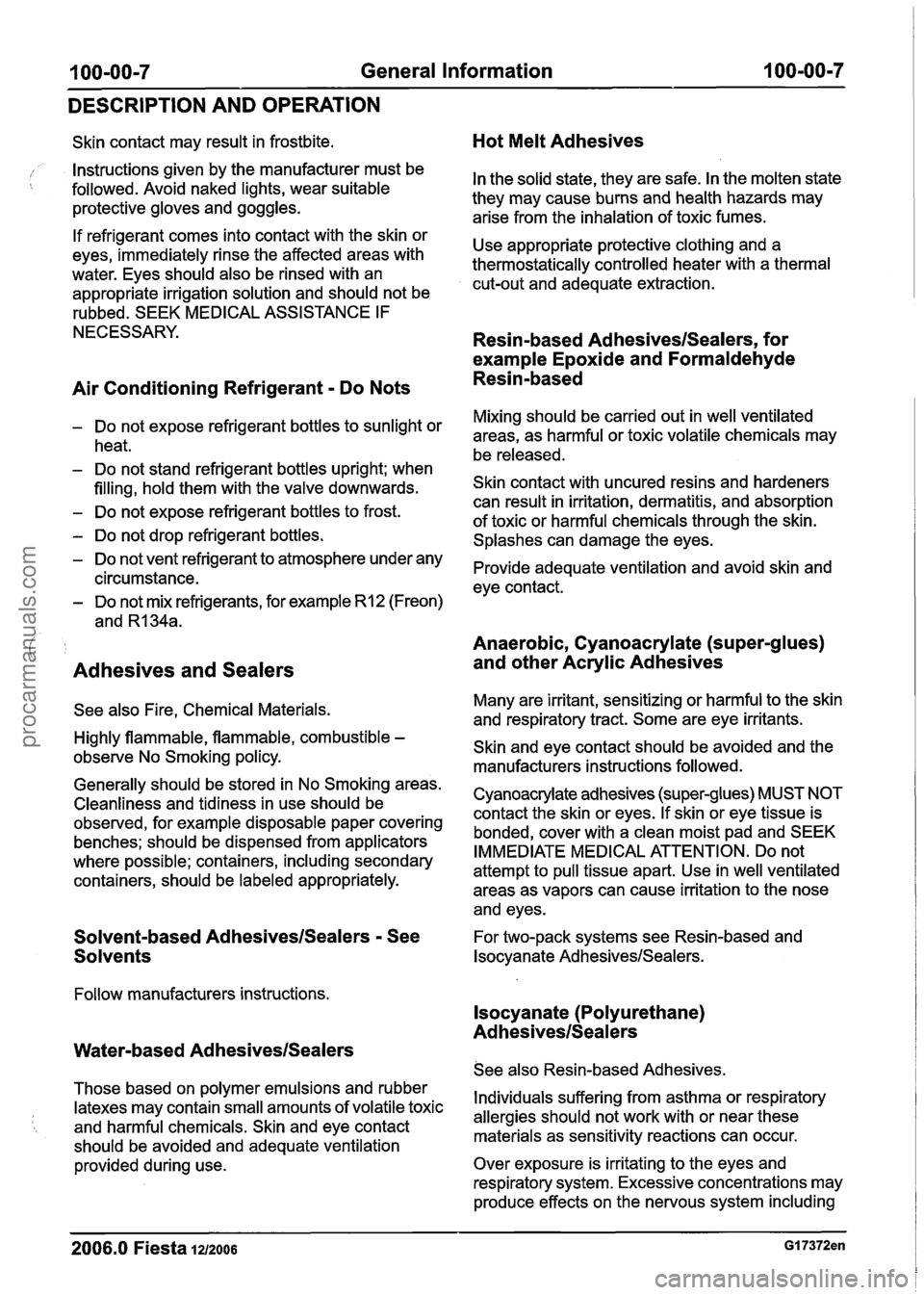
100-00-7 General Information 100-00-7
DESCRIPTION AND OPERATION
Skin contact may result in frostbite.
Instructions given by the manufacturer must be
followed. Avoid naked lights, wear suitable
protective gloves and goggles.
If refrigerant comes into contact with the skin or
eyes, immediately rinse the affected areas with
water. Eyes should also be rinsed with an
appropriate irrigation solution and should not be
rubbed. SEEK MEDICAL ASSISTANCE IF
NECESSARY.
Air Conditioning Refrigerant - Do Nots
- Do not expose refrigerant bottles to sunlight or
heat.
- Do not stand refrigerant bottles upright; when
filling, hold them with the valve downwards.
- Do not expose refrigerant bottles to frost.
- Do not drop refrigerant bottles.
- Do not vent refrigerant to atmosphere under any
circumstance.
- Do not mix refrigerants, for example R12 (Freon)
and
R134a.
Adhesives and Sealers
See also Fire, Chemical Materials.
Highly flammable, flammable, combustible
-
observe No Smoking policy.
Generally should be stored in No Smoking areas.
Cleanliness and tidiness in use should be
observed, for example disposable paper covering
benches; should be dispensed from applicators
where possible; containers, including secondary
containers, should be labeled appropriately.
Solvent-based AdhesivesISealers - See
Solvents
Follow manufacturers instructions.
Water-based Ad hesives1Sealers
Hot Melt Adhesives
In the solid state, they are safe. In the molten state
they may cause burns and health hazards may
arise from the inhalation of toxic fumes.
Use appropriate protective clothing and a
thermostatically controlled heater with a thermal
cut-out and adequate extraction.
Resin-based AdhesiveslSealers, for
example Epoxide and Formaldehyde
Resin-based
Mixing should be carried out in well ventilated
areas, as harmful or toxic volatile chemicals may
be released.
Skin contact with uncured resins and hardeners
can result in irritation, dermatitis, and absorption
of toxic or harmful chemicals through the skin.
Splashes can damage the eyes.
Provide adequate ventilation and avoid skin and
eye contact.
Anaerobic, Cyanoacrylate (super-glues)
and other Acrylic Adhesives
Many are irritant, sensitizing or harmful to the skin
and respiratory tract. Some are eye irritants.
Skin and eye contact should be avoided and the
manufacturers instructions followed.
Cyanoacrylate adhesives (super-glues) MUST NOT
contact the skin or eyes. If skin or eye tissue is
bonded, cover with a clean moist pad and SEEK
IMMEDIATE MEDICAL ATTENTION. Do not
attempt to pull tissue apart. Use in well ventilated
areas as vapors can cause irritation to the nose
and eyes.
For two-pack systems see Resin-based and
lsocyanate
AdhesivesISealers.
lsocyanate (Polyurethane)
Ad
hesives1Sealers
See also Resin-based Adhesives.
Those based On polymer emulsions and rubber Individuals suffering from asthma or respiratory
latexes may contain small amounts of volatile toxic
allergies should not work with or near these and harmful chemicals. Skin and eye contact
should be avoided and adequate ventilation materials
as sensitivity reactions can occur.
provided during use. Over
exposure is irritating to the eyes and
respiratory system. Excessive concentrations may
produce effects on the nervous system including
2006.0 Fiesta 1212006 GI 7372en
procarmanuals.com
Page 25 of 1226
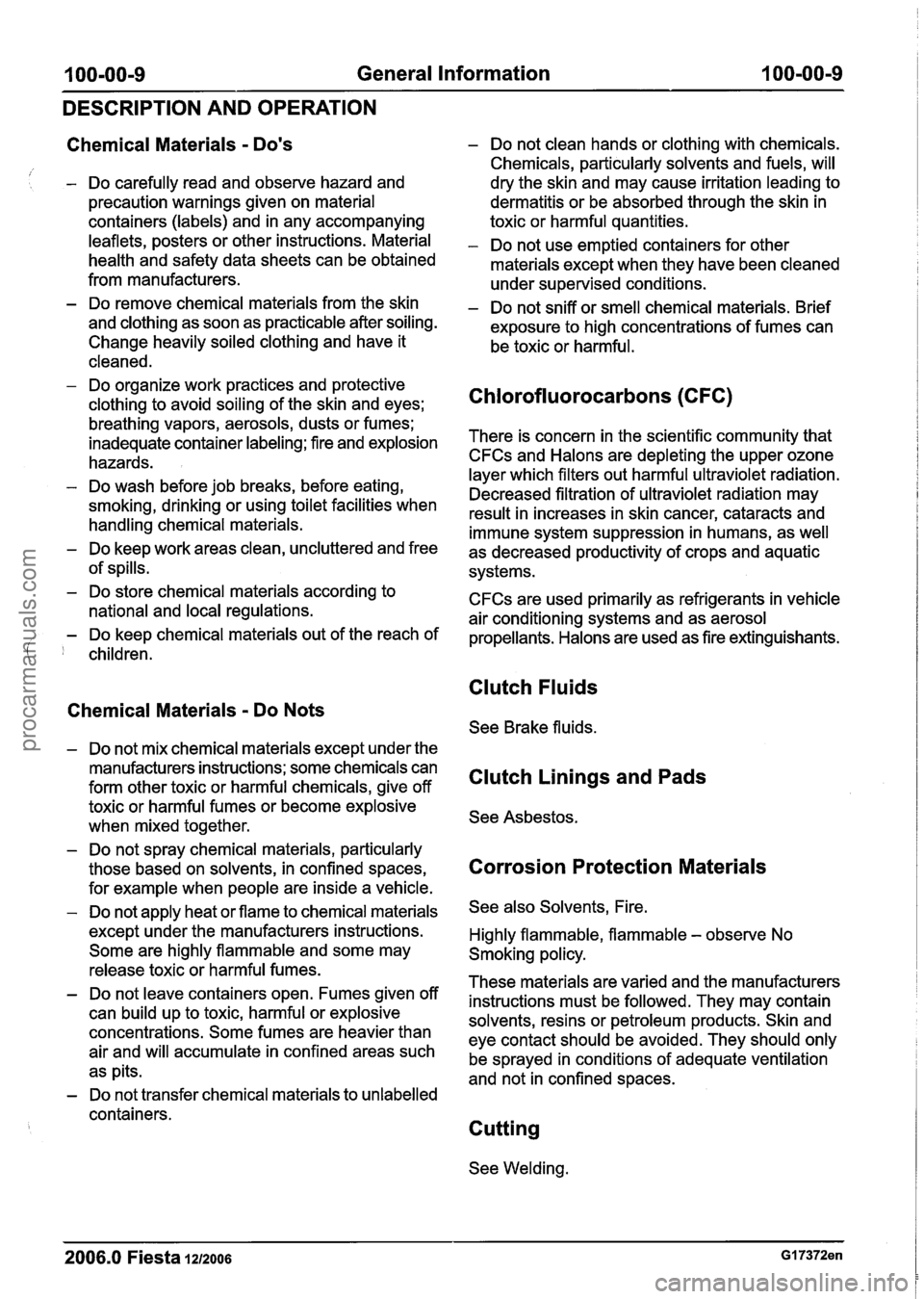
100-00-9 General Information 100-00-9
DESCRIPTION AND OPERATION
Chemical Materials - Do's
/ I - Do carefully read and observe hazard and
precaution warnings given on material
containers (labels) and in any accompanying
leaflets, posters or other instructions. Material
health and safety data sheets can be obtained
from manufacturers.
- Do remove chemical materials from the skin
and clothing as soon as practicable after soiling.
Change heavily soiled clothing and have it
cleaned.
- Do organize work practices and protective
clothing to avoid soiling of the skin and eyes;
breathing vapors, aerosols, dusts or fumes;
inadequate container labeling; fire and explosion
hazards.
- Do wash before job breaks, before eating,
smoking, drinking or using toilet facilities when
handling chemical materials.
- Do keep work areas clean, uncluttered and free
of spills.
- Do store chemical materials according to
national and local regulations.
- Do keep chemical materials out of the reach of
( ' children.
- Do not clean hands or clothing with chemicals.
Chemicals, particularly solvents and fuels, will
dry the skin and may cause irritation leading to
dermatitis or be absorbed through the skin in
toxic or harmful quantities.
- Do not use emptied containers for other
materials except when they have been cleaned
under supervised conditions.
- Do not sniff or smell chemical materials. Brief
exposure to high concentrations of fumes can
be toxic or harmful.
Chlorofluorocarbons (CFC)
There is concern in the scientific community that
CFCs and Halons are depleting the upper ozone
layer which filters out harmful ultraviolet radiation.
Decreased filtration of ultraviolet radiation may
result in increases in skin cancer, cataracts and
immune system suppression in humans, as well
as decreased productivity of crops and aquatic
systems.
CFCs are used primarily as refrigerants in vehicle
air conditioning systems and as aerosol
propellants. Halons are used as fire extinguishants.
Clutch Fluids
Chemical Materials - Do Nots
See Brake fluids.
- Do not mix chemical materials except under the
manufacturers instructions; some chemicals can
form other toxic or harmful chemicals, give off
toxic or harmful fumes or become explosive
when mixed together.
- Do not spray chemical materials, particularly
those based on solvents, in confined spaces,
for example when people are inside a vehicle.
- Do not apply heat or flame to chemical materials
except under the manufacturers instructions. Some are highly flammable and some may
release toxic or harmful fumes.
- Do not leave containers open. Fumes given off
can build up to toxic, harmful or explosive
concentrations. Some fumes are heavier than
air and will accumulate in confined areas such
as pits.
- Do not transfer chemical materials to unlabelled
containers.
Clutch Linings and Pads
See Asbestos.
Corrosion Protection Materials
See also Solvents, Fire.
Highly flammable, flammable
- observe No
Smoking policy.
These materials are varied and the manufacturers instructions must be followed. They may contain
solvents, resins or petroleum products. Skin and
eye contact should be avoided. They should only be sprayed in conditions of adequate ventilation
and not in confined spaces.
Cutting
See Welding.
2006.0 Fiesta 1212006 GI 7372en
procarmanuals.com
Page 27 of 1226
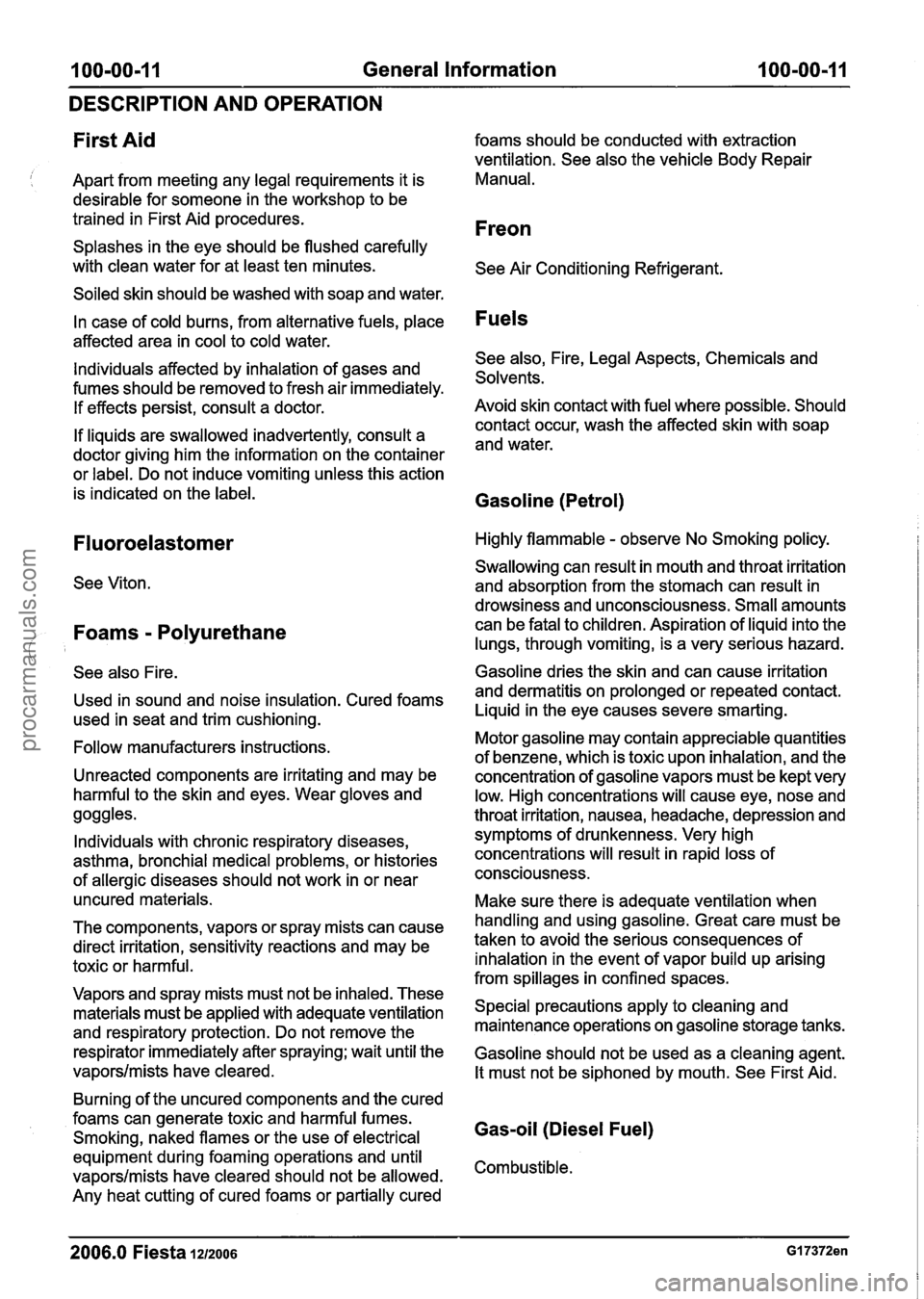
100-00-1 1 General Information 100-00-1 1
DESCRIPTION AND OPERATION
First Aid
Apart from meeting any legal requirements it is
desirable for someone in the workshop to be
trained in First Aid procedures.
Splashes in the eye should be flushed carefully
with clean water for at least ten minutes.
Soiled skin should be washed with soap and water.
In case of cold burns, from alternative fuels, place
affected area in cool to cold water.
Individuals affected by inhalation of gases and
fumes should be removed to fresh air immediately.
If effects persist, consult a doctor.
If liquids are swallowed inadvertently, consult a
doctor giving him the information on the container
or label. Do not induce vomiting unless this action
is indicated on the label.
Fluoroelastomer
See Viton.
Foams - Polyurethane
See also Fire.
Used in sound and noise insulation. Cured foams
used in seat and trim cushioning.
Follow manufacturers instructions.
Unreacted components are irritating and may be
harmful to the skin and eyes. Wear gloves and
goggles.
Individuals with chronic respiratory diseases,
asthma, bronchial medical problems, or histories
of allergic diseases should not work in or near
uncured materials.
The components, vapors or spray mists can cause
direct irritation, sensitivity reactions and may be
toxic or harmful.
Vapors and spray mists must not be inhaled. These
materials must be applied with adequate ventilation
and respiratory protection. Do not remove the
respirator immediately after spraying; wait until the
vapors/mists have cleared.
Burning of the uncured components and the cured
foams can generate toxic and harmful fumes.
Smoking, naked flames or the use of electrical
equipment during foaming operations and until
vapors/mists have cleared should not be allowed.
Any heat cutting of cured foams or partially cured foams
should be conducted with extraction
ventilation. See also the vehicle Body Repair
Manual.
Freon
See Air Conditioning Refrigerant.
Fuels
See also, Fire, Legal Aspects, Chemicals and
Solvents.
Avoid skin contact with fuel where possible. Should
contact occur, wash the affected skin with soap
and water.
Gasoline (Petrol)
Highly flammable - observe No Smoking policy.
Swallowing can result in mouth and throat irritation
and absorption from the stomach can result in
drowsiness and unconsciousness. Small amounts
can be fatal to children. Aspiration of liquid into the
lungs, through vomiting, is a very serious hazard.
Gasoline dries the skin and can cause irritation
and dermatitis on prolonged or repeated contact.
Liquid in the eye causes severe smarting.
Motor gasoline may contain appreciable quantities
of benzene, which is toxic upon inhalation, and the
concentration of gasoline vapors must be kept very
low. High concentrations will cause eye, nose and
throat irritation, nausea, headache, depression and
symptoms of drunkenness. Very high
concentrations will result in rapid loss of
CO~SC~OUS~~SS.
Make sure there is adequate ventilation when
handling and using gasoline. Great care must be
taken to avoid the serious consequences of
inhalation in the event of vapor build up arising
from spillages in confined spaces.
Special precautions apply to cleaning and
maintenance operations on gasoline storage tanks.
Gasoline should not be used as a cleaning agent.
It must not be siphoned by mouth. See First Aid.
Gasoil (Diesel Fuel)
Com busti ble.
2006.0 Fiesta 1212006 GI 7372en
procarmanuals.com
Page 65 of 1226
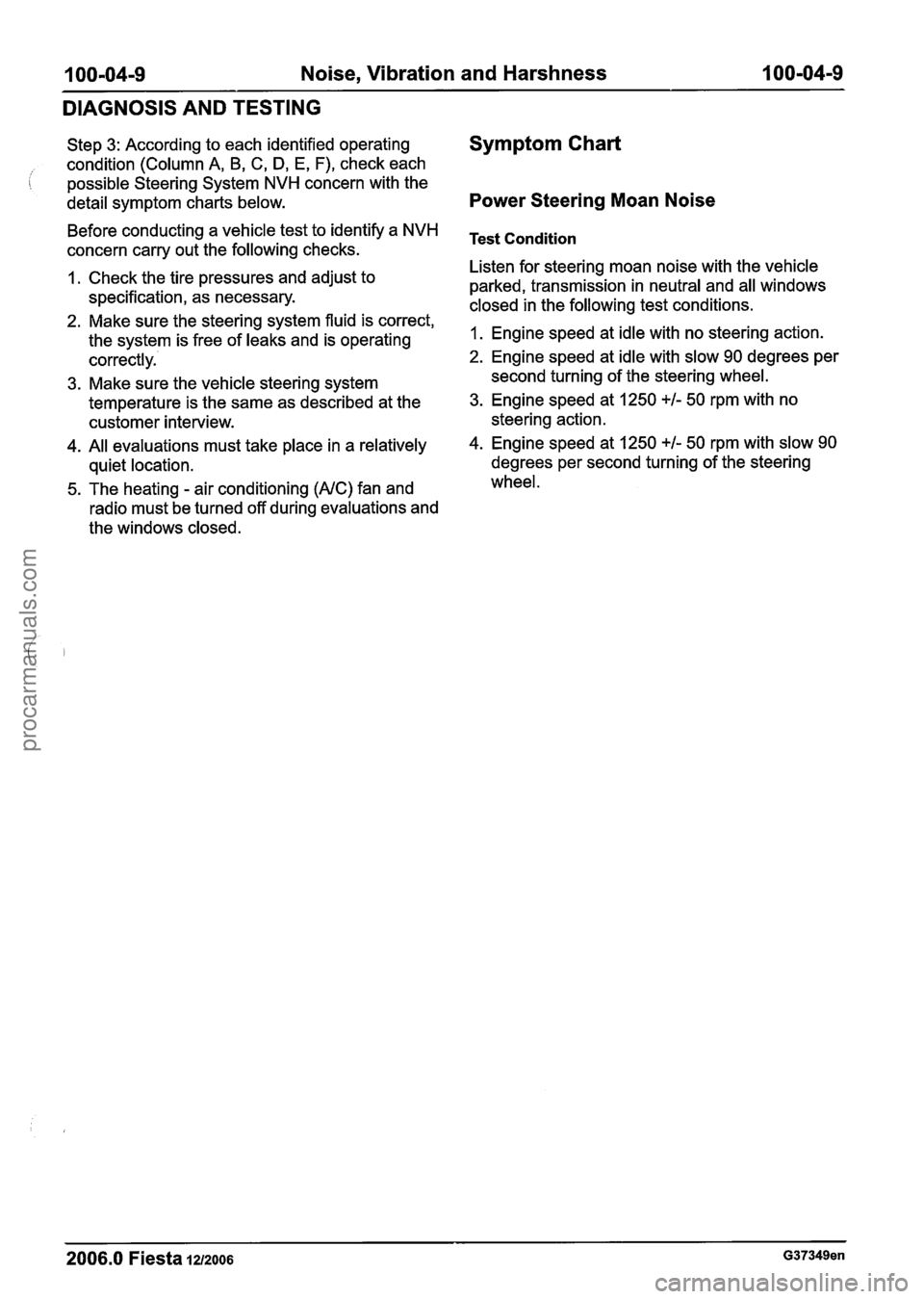
100-04-9 Noise, Vibration and Harshness 1 00-04-9
DIAGNOSIS AND TESTING
Step 3: According to each identified operating
condition (Column A, B,
C, D, E, F), check each
possible Steering System
NVH concern with the
detail symptom charts below.
Before conducting a vehicle test to identify a
NVH
concern carry out the following checks.
1. Check the tire pressures and adjust to
specification, as necessary.
2. Make sure the steering system fluid is correct,
the system is free of leaks and is operating
correctly.
3. Make sure the vehicle steering system
temperature is the same as described at the
customer interview.
4. All evaluations must take place in a relatively
quiet location.
5. The heating
- air conditioning (AIC) fan and
radio must be turned off during evaluations and
the windows closed.
Symptom Chart
Power Steering Moan Noise
Test Condition
Listen for steering moan noise with the vehicle
parked, transmission in neutral and all windows
closed in the following test conditions.
1. Engine speed at idle with no steering action.
2. Engine speed at idle with slow 90 degrees per
second turning of the steering wheel.
3. Engine speed at 1250 +I- 50 rpm with no
steering action.
4. Engine speed at 1250 +I- 50 rpm with slow 90
degrees per second turning of the steering
wheel.
2006.0 Fiesta 12/2006 G37349en
procarmanuals.com
Page 72 of 1226

100-04-16 Noise, Vibration and Harshness 100-04-1 6
DIAGNOSIS AND TESTING
Driveline Noise and Vibration
Suspension Noise and Vibration
Action
GO to Pinpoint Test A.
GO to Pinpoint Test
B.
GO to Pinpoint Test C.
Symptom
Shake and vibration while driving
Tip-in moan
Idle boomlshake/vibration/
shudder
Pinpoint Tests steps necessary to correct the condition. Then
check the operation of the system to make sure
N0TE:These Pinpoint Tests are designed to take the
condition has been corrected.
the technician through
a step-by-step diagnosis ~fi~~ verifying that the condition has been procedure to determine the cause of a condition. corrected, make sure all components removed It may not always be necessary to follow the chart have been installed. to its conclusion. Carry out only the pinpoint test
PINPOINT TEST A : SHAKE AND VIBRATION WHILE DRIVING
TEST CONDITIONS
DETAILSIRESU LTSIACTIONS 1
Possible Sources
Wheel end vibration.
. Engine/transmissiOnm
Air cleaner.
Power assisted steering.
Powertrain.
Powertrainldrivetrain mounts.
Exhaust system.
Cable(s)lhose(s).
Powertrainldrivetrain mounts.
Exhaust system.
Belt/ pulleys.
I A1 : NEUTRAL COAST I
Action
GO to Pinpoint Test D.
GO to Pinpoint Test E,
Symptom
Wheel end vibration analysis
Nan-axle noise
Carry out the neutral coast test.
Does the vibration disappear during the neutral
coast test?
+ Yes
GO to A2.
+ No
GO to Pinpoint Test D.
Possible Sources
Suspension.
. Wheel bearings,
Trim panels.
Air conditioning (A/C) system.
Accessories.
- --
2006.0 Fiesta 1212006 G37349en
procarmanuals.com
Page 75 of 1226
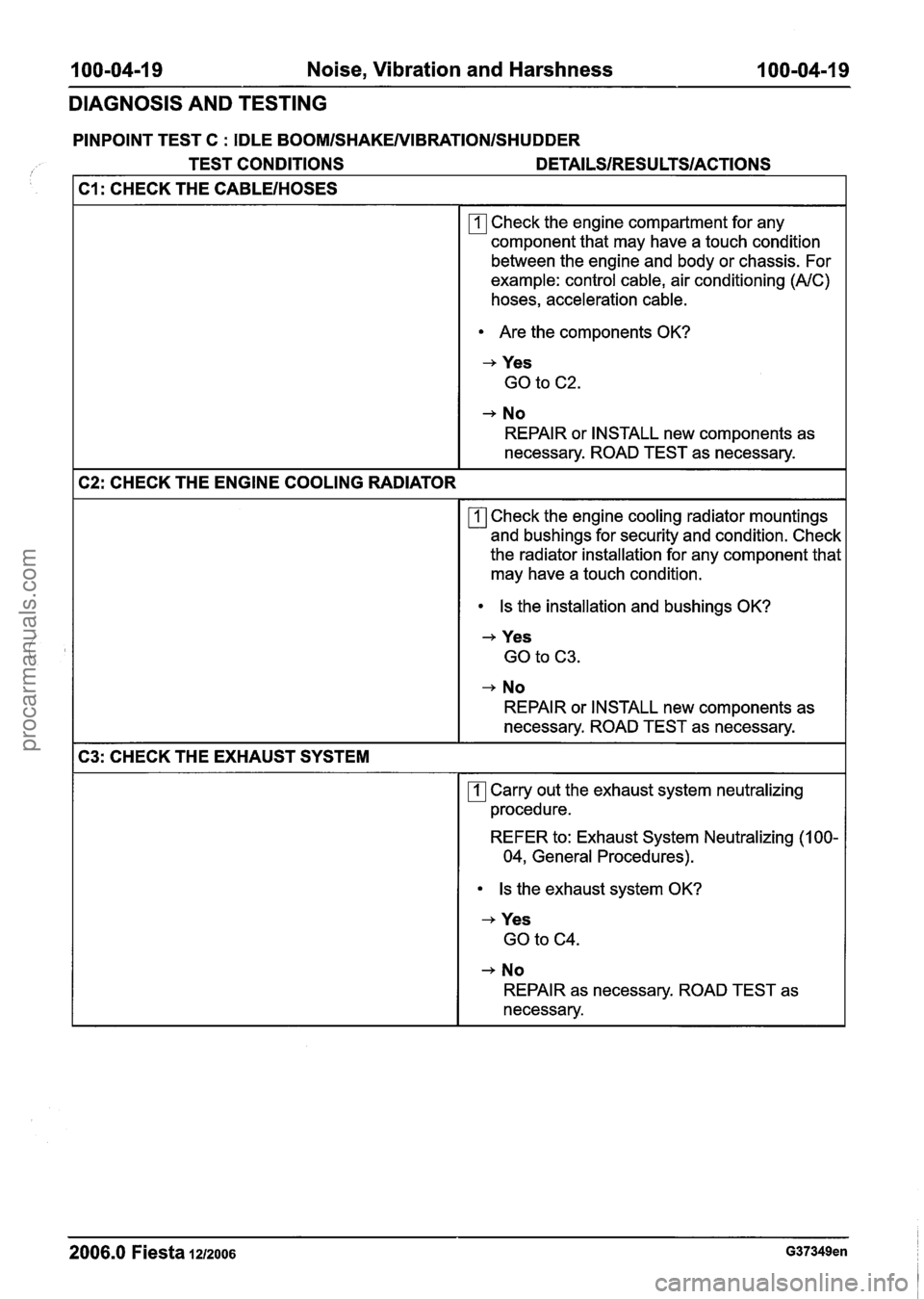
I 00-04-1 9 Noise, Vibration and Harshness 100-04-19
DIAGNOSIS AND TESTING
PINPOINT TEST C : IDLE BOOMISHAKENIBRATIONISHUDDER
1 TEST CONDITIONS DETAILSIRESU LTSIACTIONS
C1: CHECK THE CABLEIHOSES
rn Check the engine compartment for any
component that may have a touch condition
between the engine and body or chassis. For
example: control cable, air conditioning
(AIC)
hoses, acceleration cable.
Are the components OK?
-+ Yes
GO to C2.
+ No
REPAIR or INSTALL new components as
necessary. ROAD TEST as necessary.
C2: CHECK THE ENGINE COOLING RADIATOR
rn Check the engine cooling radiator mountings
and bushings for security and condition. Check
the radiator installation for any component that
may have a touch condition.
Is the installation and bushings OK?
+ Yes
GO to C3.
-+ No
REPAIR or INSTALL new components as
necessary. ROAD TEST as necessary.
C3: CHECK THE EXHAUST SYSTEM
rn Carry out the exhaust system neutralizing
procedure.
REFER to: Exhaust System Neutralizing
(1 00-
04, General Procedures).
Is the exhaust system OK?
+ Yes
GO to C4.
+ No
REPAIR as necessary. ROAD TEST as
necessary.
2006.0 Fiesta 1212006 G37349en
procarmanuals.com